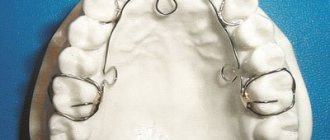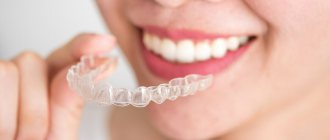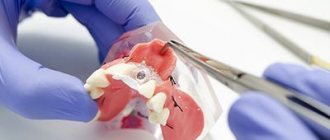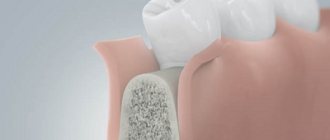Are you planning microimplant orthodontic treatment with the installation of braces? Perhaps you, as a potential patient, are considering microimplants as an alternative to traditional implants that are screwed into the bone? Everything you need to know about microimplants, indications for their use and possible contraindications is in our material. Experts share their independent opinions and reveal facts that are not always discussed in dentistry. Read the material to the end to be aware of all the important nuances.
Indications for the use of microimplants
- Orthodontic treatment. In orthodontics, mini-implants are used as additional support for a brace system. Their installation is required if selective correction of the position of the teeth is required. For example, if one tooth is displaced relative to its axis or has an incorrect position. However, all other teeth do not require correction. Fixing a brace on an adjacent healthy tooth can lead to the risk of it moving. A microimplant allows you to reduce this risk to zero. It is screwed into the gum and serves as a support for the braces system, balancing the pressure. The teeth move along the trajectory planned by the orthodontist. In this case, healthy units are not affected. After treatment is completed, the rod is removed.
- Orthopedic treatment. In orthopedics, microimplants are used as a support for removable dentures. To fix the prosthesis, it is usually necessary to implant 4-6 microimplants, after which the system copes well with the occlusal load. Due to their miniature size, they take root even in the upper jaw with bone atrophy. The microimplant can be loaded immediately after installation, without waiting for complete osseointegration. Compared to classic implantation, this is a less invasive procedure. Therefore, it is suitable as an alternative to conventional dental implantation for certain contraindications. A microimplant can be installed in case of bone atrophy, contraindications to osteoplasty, or complicated clinical picture.
General overview
Mechanical devices have an impact on the bite and individual elements due to the force inherent in the design. The chewing muscles do not take part in the process.
The required force is provided by individual elements of the devices: a screw, a spring, an inclined arc and a rubber rod. The degree of pressure is adjusted by the dentist.
The degree of force of the systems should not exceed the value of capillary pressure - 20 g/cm2. This value will provide the conditions necessary for the reconstruction of bone and tissue adjacent to the unit. With excessive force, prolonged compression of nerve endings and capillaries occurs, which leads to the development of tissue ischemia, resorption of the jaw bone, the formation of a focus of necrosis and an increase in the mobility of units. The listed negative phenomena prevent correct correction.
Mechanical systems are predominantly non-removable structures and are intended to be worn constantly.
Contraindications
Microimplants are less traumatic than conventional implants, but their installation has a number of contraindications. Most of them are not absolute. A final decision on the possibility of installing a microimplant will require examination and, possibly, additional treatment. Contraindications include:
- Diabetes mellitus in the stage of decompensation.
- Inflammation in the oral cavity.
- Gum diseases.
- Loose bone tissue.
- Mental illnesses.
- Oncological diseases.
Microimplants should not be placed on patients who smoke. Smoking slows down the healing process, which can cause various complications and reduce the effectiveness of orthodontic treatment. Therefore, patients who are not ready to give up the habit will have to use alternative options.
How is the Haas apparatus installed?
In fact, installing the device in the attending physician’s office is quite simple and does not take long:
- In a friendly atmosphere, we clean the enamel of plaque with a pleasant aromatic paste.
- We use dental glue - a safe cement - and fix the device onto the primary chewing teeth and canines.
- Excess filling material is removed and the interdental spaces are cleaned.
- The composite material becomes strong under the light of the lamp.
I use modern technologies and equipment; my child and I discuss the design of the device and the need for its installation as equals. Before the correction begins, together with the parents we discuss the problem and ways to solve it. Make an appointment and we will make sure your baby's teeth are perfect.
Advantages of microimplants in orthodontic treatment
- Reducing treatment time. During orthodontic treatment, the patient wears a non-removable corrective appliance for a long time. The use of microimplants allows you to reduce the time required for bite correction.
- Lightening the braces system. In traditional treatment, additional elements are used to provide a counterweight, which are attached to the braces. This makes the structure heavier and can cause discomfort for the patient.
- Correction accuracy. The pressure force of the bracket system and the speed of tooth movement are planned at the preparatory stage of orthodontic treatment. Since microimplants, rather than your own teeth, are used as support for braces, a more accurate calculation can be made.
- Good survival rate. Despite the fact that microimplants are a relatively new technology in orthodontic treatment, we can already say that they take root well and do not cause complications. There is no risk of rejection, inflammation, or damage to bone tissue. Therefore, mini implants can be used even in patients with thinning gums.
- Installation in the right place. The microimplant is short in length, so it can be implanted anywhere in the gums. On the upper jaw they can be installed next to the maxillary sinuses. There is no risk of damaging them during implantation.
- Easy to remove. For orthodontic treatment, a titanium screw is installed for a period of about six months. After which it is removed from the gums without damaging the tissue.
Price
| Click to sign up for a FREE consultation |
The price of the devices is relatively reasonable:
- with Coffin spring from approximately 14,000;
- with screw for the upper jaw from 15000;
- with fan-shaped propeller from 19000;
- with Koller spring from 18000;
- with screw for the lower jaw from 20,000.
This is the price exclusively of the structures themselves. It is also necessary to pay for diagnostics, drawing up a treatment plan, calculating pressure parameters, and subsequent maintenance of the mechanical device.
The effectiveness of these devices for changing the bite is undeniable. All inconveniences during use and maintenance are eliminated by the end result.
Advantages of microimplants in prosthetics
- You can do without bone grafting. For primary stabilization of the implant, a sufficient amount of bone tissue is required. If a tooth has been lost for a long time, the bone will atrophy. A traditional implant can be installed only after osteoplasty. Microimplants require less bone volume, so they can be implanted in patients with bone atrophy.
- Can be used for immediate load protocols. The microimplant is able to withstand occlusal load normally. Therefore, such systems can be used for implantation with immediate loading of a lightweight adaptive prosthesis. Immediately after the operation, the patient can lead a normal life, following the doctor’s recommendations.
Installation of a microimplant is a minimally invasive procedure. The rod is screwed through a puncture in the gum, so there is no need for suturing. The risk of infection, rejection, and peri-implantitis is minimal.
Implantation stages
Just like before classical implantation, the installation of microimplants requires a preparatory stage and diagnostics. The implantologist prescribes an instrumental examination: x-ray, panoramic image, computed tomography. The images help to assess the location of teeth and their roots, the volume and density of bone tissue. Using the images, the doctor makes 3D modeling and plans the operation.
Oral preparation will also be required. It is necessary to undergo examination by a dentist. If caries or other oral diseases are detected, they are first treated. If there are contraindications, consultation with a specialized specialist may be required.
If there are no contraindications, the doctor will prescribe the procedure. The implantation of microimplants is a minimally invasive operation that takes about 15 minutes. The installation is done under local anesthesia. In some cases, if there are indications, for example, the patient’s panic, sedation is used.
The surgical stage does not require cutting the gum and its subsequent suturing. The implantologist makes a small puncture into which a screw is screwed. Since mini-implants have good primary stabilization, an orthodontic appliance or an adaptive prosthesis can be installed immediately.
After completion of the procedure, the doctor will give recommendations for oral care. If necessary, he will recommend anti-inflammatory and painkillers. Despite the fact that the implantation of microimplants is a gentle, low-traumatic procedure, in the first days there may be pain, swelling of the gums, and slight bleeding. These are normal phenomena that will go away on their own within 2-3 days.
Design Features
Bioray systems come in a variety of designs and sizes. The main parameters include the diameter and length of the screw body. They are indicated by two numbers, the first of which indicates the diameter, the second - the length.
For example, the designation 2.0x14mm means that the screw has a diameter of 2mm and a length of 14mm. In addition to the dimensions, the designation indicates the area for installation in which the structure is intended.
There are three standard installation zones for Bioray miniscrews:
- Subzygomatic (zone IZC). It is recommended to install systems in this area to create support for distal displacement of the upper molars, as well as retraction and protraction of the jaws.
For example, a mini-implant designated IZC A-1P 2.0×17 mm is intended for installation in the subzygomatic area, has a diameter of 2 mm, and a length of 17 mm. The designation A-1P indicates the tip of the instrument for inserting and removing a mini-implant. - Oblique line on the lower jaw (Buccal Shelf area or BS for short). Orthodontic bone supports are installed in this area for distal displacement of the lower molars. The designation is BSS A-1PL 2×12 mm.
- The interroot zone of the frontal teeth of the lower and upper jaw is an area for installing orthodontic mini-implants with vertical displacement of the central teeth - intrusion or extrusion. An example of the designation of such a screw is A-1PL 2×12 mm.
But in essence, Bioray structures can be installed in any area of the jaws, depending on the task facing the orthodontist.
The only requirement is that there is enough bone density to hold the screw, which can be controlled tactilely. If the screw “falls” into the bone when pressed lightly, you need to find another place to install it.
Bioray systems are available in a variety of sizes - 1.4×7, 1.4×8, 1.5×8, 1.5×10, 1.5×12, 2.0×8, 2.0×10, 2.0×12, 2.0×14, 2.0×17 mm. The hole in them for attaching the power elements can be round or square, made in a groove under the cap, in a cylindrical supporting part, or absent altogether.
The kit includes tools for installing and removing them - a handle and a set of blade screwdrivers, designated by an alphanumeric code, for example, A-1PII.
How do microimplants differ from traditional implantation systems?
The main design difference is the size of microimplants. They are much smaller than traditional implant systems. They also differ in purpose of use. Their main purpose is orthodontic treatment. This is a temporary structure that will act as additional support for the braces system. After treatment is completed, the screw is removed from the gum. In prosthetics, microimplants are used to fix lightweight removable dentures when it is not possible to do full-fledged dental implantation.
Dental implants are intended for the treatment of edentia, including complete edentia. They replace the root of the tooth and serve as a support for a fixed prosthesis. Good survival rate and long service life are very important for dental implants. Micro implants are usually removed several months after treatment is completed.
Areas of use
As already noted, Bio-Ray miniscrews are intended for use in cases where additional anchorage is required. The most common indications for installing miniscrews include the following tasks:
- Distal displacement of the upper and lower fillers is a case when it is not possible to use natural teeth as supporting teeth.
- Vertical displacement of teeth.
- Retraction or protraction of the upper or lower jaw.
The table below presents specific cases in which it is recommended to use miniscrews, supplemented by recommendations for their size and installation location.
| Indication | Installation location | Screw size | Note |
| HF protraction | IZC | A-1 IZC 2×14 mm | — |
| Palatal impaction of canines | Sky | A-1PL 2×12 mm | — |
| LF retraction | B.S. | A-1PL 2×12 mm, A-1PL 2×14 mm | — |
| Impaction of the maxillary canine | IZC | A-1 IZC 2×14 mm | Combined with 3D lever |
| Impaction of the mandibular canine | B.S. | A-1PS (with torque) 2×12 mm | Combined with 3D lever |
| Impaction of the mandibular molar | LF branches | A-1 IZC 2×14 mm | — |
| LF protraction | B.S. | A-1PL 2×14 mm | — |
| Gummy smile (premaxillary intrusion) | Between the roots of the incisors | A-1PL 1.5×8 mm | — |









